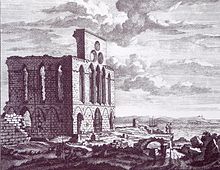St. Andrew (Acre)
St. Andrew was a Crusader parish church in Acre in what is now Israel . A Gothic marble portal was brought to Cairo as a war trophy , where it can still be seen today.
history
St. Andreas was mentioned in 1187 as part of a donation by Konrad von Montferrat to the Pisans . According to the Pelgrinages et Pardouns de Acre (1258–64), a visit to St. Andrew's Church resulted in five years of indulgence . Another report from the 13th century named the church as a navigation mark for reaching the port of Acre.
After the conquest of Akkon on May 18, 1291 by the Mamluks , their Sultan Chalīl commissioned his emir ʿAlam al-Din Sanjar al-Schujaʿi al-Mansuri (عَلَمُ الدِّينِ سَنْجَرُ الشُّجَاعِيُّ المَنْصُورِيُّ, DMG ʿAlam ad-Dīn Sanǧar aš-Šuǧāʿī al-Manṣūrī ) to grind down the churches and fortifications of Akko in order to erase Christian traces and to make it impossible for the Crusaders - after a possible reconquest - to use them again as a base. Parts of St. Andreas escaped destruction because they could still be used as a navigation mark for the port. Representations from the 17th century still show essential parts standing upright. Today, at this location , which is suitable for navigation marks, there is Akko's Franciscan Church of St. Johannis , which includes the structures of a crusader church from the 12th century, which is most likely the medieval St. Andrew's Church.

Through Emir dasAlam al-Din Sandjar al-Schudschaʿi al-Mansuri, a portal, which may have come from St. Andrew, came to Cairo as a war trophy, where it was included in the medressat to-Nāsir Muhammad ibn Qalāwūn under Sultan al-Adil in 1295 . Jim Antoniou, on the other hand, suspects that said portal comes from Akko's Holy Cross Cathedral, while Alexander Papadopoulos believes it comes from St. George's Church, whereas more recent research on dimensions and shapes by Vardit Shotten-Hallel ( וַרְדִּית שׁוֹטֶּן-הַלֵּל) suggest that the portal was rather part of Acco's Johanniterkirche St. Johannis in the complex of the former Johanniterkommende there.
Presumably towards the end of the 1740s, the Franciscans handed over their St. John's Church to the Melkites , who were newly united with Rome , who at that time formed the largest religious community in Akko. Ibrāhīm al-Ṣabbāġ (around 1715–1775), from 1757 personal physician and from 1761 also vizier of the Arab regional potentate Ẓāhir al-ʿUmar (1690–1775), financed the construction of the Melkite Church of St. Andrew from 1760 , which was completed in 1764. It includes structures from the Templar Church of St. Anna, which was destroyed in 1291. The Franciscan church was then used again by Latins , who expanded it to include rooms north of the church in 1178 of the Hijra (Gregorian 1764/1765), as the purchase contract shows.
Construction and plant
St. Andrew was built around 1200 as a three-aisled Gothic basilica with at least six bays . Today's Greek Catholic Church is not a reconstruction of the old church.
literature
- Denys Pringle, The Churches of the Crusader Kingdom of Jerusalem. A Corpus : 4 Vols., Cambridge, Engl .: Cambridge University Press, 2009, Vol. IV 'The Cities of Acre and Tire with Addenda and Corrigenda to Volumes I-III', pp. 63-69 (Church), pp. 24f. (Portal). ISBN 9780521109833 .
Individual evidence
- ↑ a b Vardit Shotten-Hallel, “Reconstructing the Hospitaller Church of St. John, Acre, with the help of Gravier d'Ortières's drawing of 1685-1687”, in: Crusades , Vol. 9 (2010), pp. 185– 198, here p. 195.
- ^ Ze'ev Goldmann , "The Hospice of the Knights of St. John in Akko", in: Archeological Discoveries in the Holy Land , Archeological Institute of America (compiled), New York: Thomas Y. Crowell Co., 1967, Pp. 199–206, here p. 200.
- ↑ Erhard Gorys, Das Heilige Land: Historical and religious sites of Judaism, Christianity and Islam in the 10,000 year old cultural land between the Mediterranean, Red Sea and Jordan , Cologne: DuMont, 2 1984, (= DuMont art travel guide), p. 370. ISBN 3-7701-1474-4 .
- ↑ Jaʿel Fuhrmann [-Naʿaman] (יָעֵל פוּרְמַן-נַעֲמָן) and Adi Kitov (עֲדִי כּיטוֹב ʿAdī Kīṭōv ) on behalf of the Department of Monument Preservation of the Israel Antiquities Authority (ed.), Nomination of the Old City of Acre for the World Heritage List , (= WHC Nomination Documentation; No. 1042), Paris: UNESCO, 2001, section 'Acre (Israel) No. 1042 ', p. 3
- ↑ Jack Bocar, "Quartier Templiers emplacement des structures" , in: L'Orient Latin: La Terre Sainte à l'époque Romane - L'Orient au Temps des Francs , accessed on August 21, 2019.
- ↑ Thomas Philipp, Acre: the rise and fall of a Palestinian city, 1730-1831 , New York and Chichester: Columbia University Press, 2001, (= History and society of the modern Middle East series; Vol. 6), p. 177 . ISBN 0-231-12327-2 .
- ↑ Thomas Philipp, Acre: the rise and fall of a Palestinian city, 1730-1831 , New York and Chichester: Columbia University Press, 2001, (= History and society of the modern Middle East series; Vol. 6), p. 108 . ISBN 0-231-12327-2 .
- ↑ Bernhard Dichter with Salman cotton (arrangement), Alex Carmel ( arrangement ) and Ejal Jakob Eisler ( arrangement ), עַכּוֹ - אֲתָרִים מִיָּמֵי הַתּוּרְכִּים /عكا: مواقع من العهد التركي(Additional title: Akko, buildings from the Turkish period / Akko, sites from the Turkish period ), University of Haifa /הַמָּכוֹן עַל שֵׁם גּוֹטְלִיבּ שׁוּמַכֶר לְחֵקֶר פְּעִילוּת הָעֹולָם הַנּוֹצְרִי בְּאֶרֶץ יִשְׂרָאֵל בַּמֵּאָה הַ -19 (Gottlieb Schumacher Institute for Research into the Christian Contribution to the Reconstruction of Palestine in the 19th Century; Ed.), Haifa: הַמָּכוֹן עַל שֵׁם גּוֹטְלִיבּ שׁוּמַכֶר לְחֵקֶר פְּעִילוּת הָעֹולָם הַנּוֹצְרִי בְּאֶרֶץ יִשְׂרָאֵל בַּמֵּאָה הַ -19, 2000, p. 157.
Web links
Coordinates: 32 ° 55 ′ 12.5 " N , 35 ° 4 ′ 1.8" E
